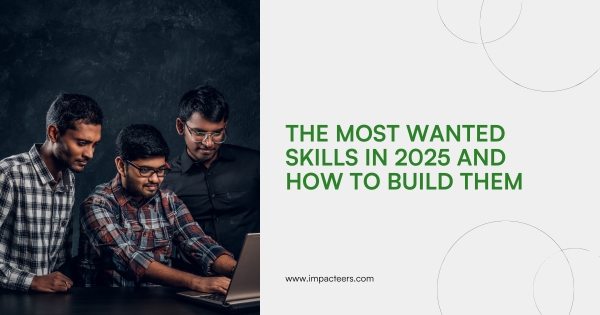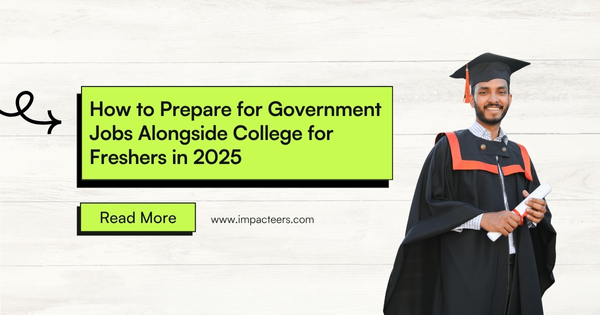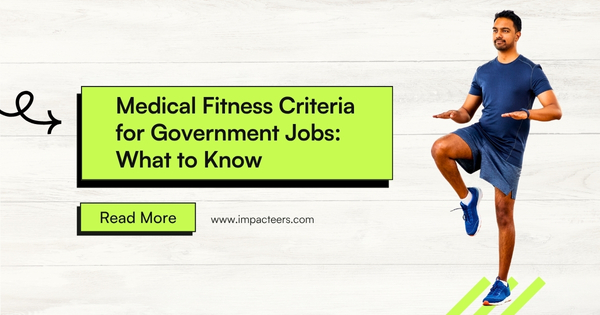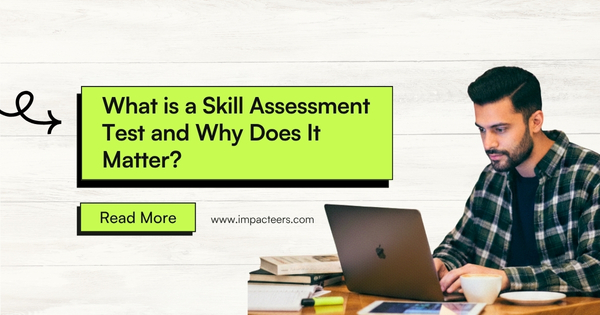Future skills are the abilities that prepares students and professionals to be successful in the relevant, adaptable and rapidly changing world.
The world of work isn’t slowing down. Jobs are changing names, roles are blending, and new tools pop up every quarter. That’s exciting—and a little scary. This is where career coaching earns its keep. The right coach helps you sort the noise, pick the right moves, and turn learning into results.
Let’s walk through the most wanted future skills for 2025. You’ll see plain-spoken examples, quick exercises, and simple ways to track progress with a skill assessment or an assessment test. Keep your LinkedIn open—you’ll update it as you go.
Visit Us >>>> https://www.impacteers.com/home
1) Communication that actually lands
Good communication is never “extra.” It’s the job. Whether you’re in engineering, sales, support, or management, you’ll write, present, and listen—daily.
How to build it
- Do a 5-minute voice note each morning. Explain a concept you learned yesterday—as if to a classmate.
- Pick one meeting a week where you summarise decisions in two crisp paragraphs. Post the cleaned-up version on LinkedIn.
- Take a short online education module on storytelling for work. Practice on your next deck.
Mini test
Record a 90-second pitch about your current project. Play it back. Could a stranger follow it? If not, trim jargon and reorder the points: problem → action → result.
2) Problem-solving and critical thinking
By 2025, teams need people who can untangle messy stuff. Not just spot issues, but test options and move.
How to build it
- Try “three options” every time you’re stuck: fix now, fix later, or remove the need.
- Use a whiteboard method: what we know, what we don’t, what we’ll test this week.
- Join a weekend case club or hackathon. It’s low-risk, high learning.
Assessment test idea
After each project, write a one-pager: assumptions, what broke, what worked, next training you need. Share it with a peer for feedback.
3) Data comfort (not just data jobs)
You don’t have to be a data scientist. But reading a chart, building a simple model, or asking for the right metric? That’s gold.
How to build it
- Learn the basics of Excel/Sheets: filters, pivots, simple regressions.
- Add one metric to your weekly routine: response time, defect rate, cost per lead—anything tied to outcomes.
- Earn a short certification in data analytics and add it to LinkedIn.
Quick win
Pick one recurring meeting and bring a chart—not a paragraph. Watch how the conversation sharpens.
4) Tech fluency for non-tech roles
Every job touches software now. PMs run roadmaps. Recruiters use ATS. Marketers ship experiments. Fluency beats fear.
How to build it
- Shadow a teammate in a tool you don’t know. Ask dumb questions. Take notes.
- Complete a weekend crash course—API basics, cloud, or Git—just enough to talk to devs.
- List three tools you’ll test in Q1. Tie each to a result (speed, quality, cost).
Skill assessment tip
Score yourself 1–5 on core tools for your role. Anything under 3 becomes your next sprint.
5) Collaboration and conflict that stays kind
Hybrid teams mean more written decisions and fewer hallway fixes. Clear process saves energy.
How to build it
- Use the “who/what/when” rule on every shared task.
- Replace “why did you…” with “what led to…” in tough chats. Tone changes outcomes.
- Keep a decision log in your team doc. One page. No drama.
Tiny practice
In your next disagreement, restate the other person’s goal before you offer your view. People listen after they feel heard.
6) Product thinking (even if you never ship a product)
Jobs in 2025 reward people who link effort to a customer’s outcome. That’s product thinking.
How to build it
- Meet one user a month. Ask what they tried before your solution.
- Write a mini brief for each change: user, pain, hypothesis, metric, rollout plan.
- In management updates, talk impact first, activity last.
Assessment test
Can you explain your project’s value in one sentence a non-expert understands? If not, rewrite until your neighbour nods.
7) Leadership without the title
Teams follow people who move work forward, share credit, and stay calm under pressure.
How to build it
- Volunteer to run a retro or a planning session.
- Keep a brag doc: wins, lessons, thank-yous from others. It feeds reviews and your careers story.
- In 1:1s, ask “What’s stuck and how can I help?” Then pick one concrete action.
Career coaching angle
A coach can stage small leadership reps so you don’t wait years for a manager badge.
8) Writing that reduces meetings
Clear writing halves confusion. It’s leverage.
How to build it
- Adopt a template: context, options, decision, next steps.
- Swap adjectives for numbers. “Better” = by how much?
- Edit once for length, once for clarity. Hit send only after both.
LinkedIn tip
Share short lessons (100–150 words) from your week. People follow voices that teach by doing.
9) Learning speed (and staying power)
Tools change. Principles stick. Build a system, not a streak.
How to build it
- Use spaced repetition for facts; projects for depth.
- For each quarter, pick one training theme and one project to apply it.
- Join a cohort for accountability; solo plans fade fast.
Certification plan
Stack two bite-size certification badges around one deeper programme. Breadth plus depth looks strong on LinkedIn and in interviews.
10) Ethics and safety in a hurry-up world
Shortcuts can cost trust. Good judgment is a career moat.
How to build it
- Keep a personal “red lines” list. Share it with your team.
- Pressure-test plans: who could this harm, even by accident?
- When you ship fast, document fast too.
Where career coaching fits (and why it saves time)
You can piece this journey together alone. Or you can pair up with career coaching that trims detours. A solid coach will help you:
- Map the next role with the skills it really values.
- Pick the right online education path instead of hoarding courses.
- Choose one assessment test to measure growth every month.
- Turn experience into a crisp story for management and hiring teams.
- Tighten your LinkedIn brand so recruiters see the signal, not the noise.
Think of it like this: you still do the work; coaching keeps the road clear.
A practical 12-week plan (reuse it any time)
Weeks 1–2: Baseline & goals
- Self skill assessment (1–5) across communication, data, tools, leadership.
- Update your LinkedIn headline and “About” to reflect the skills you’re building.
- Book two conversations: one manager, one mentor. Align on outcomes.
Weeks 3–4: Communication sprint
- Daily 5-minute voice notes.
- One presentation to peers; ask for blunt feedback.
- Post a weekly learning thread on LinkedIn.
Weeks 5–6: Data sprint
- Finish an entry certification in analytics or BI.
- Replace one status mail with a chart and two insights.
- Short assessment test on Excel/Sheets to check progress.
Weeks 7–8: Tool fluency
- Shadow a teammate for a day.
- Build a tiny automation (template, macro, or script) that saves the team 15 minutes a week.
- Document the before/after and share.
Weeks 9–10: Leadership reps
- Facilitate one retro.
- Pair with a junior on a mini task. Practice coaching, not doing.
- Write a one-page decision memo; ship it.
Weeks 11–12: Portfolio & pitch
- Compile a proof pack: screenshots, metrics, lessons.
- Run two mock interviews—one friendly, one tough.
- Refresh your resume with numbers; add new certification badges.
Rinse, adjust, repeat. When roles shift, keep the skeleton, swap the sprints.
For engineering grads (and engineers moving roles)
You’ve got the base: logic, systems, detail. For 2025, stretch across the stack.
- Pair business impact with commits. “Cut build time by 32%” beats “migrated pipeline.”
- Run small experiments and publish the write-ups.
- Learn to speak in trade-offs: latency vs. cost, scope vs. reliability.
- Add one product metric you own—crash rate, load time, adoption. Track it weekly.
Assessment test idea
Time yourself solving one real bug with a rubber-duck narrative. If you can teach it clearly, you understand it.
For new managers or soon-to-be leads
Management in 2025 is clarity plus care.
- Create two rituals: weekly priorities (three bullets), monthly strategy (one page).
- Write role scorecards with measurable outcomes. Hiring becomes easier.
- Train your team to disagree well. It saves projects.
- Keep a runway of growth tasks so people see a path, not just a chair.
Career coaching tip
Use coaching to practice hard talks: scope cuts, missed deadlines, promotions you can’t approve—yet.
Make LinkedIn work while you sleep
Treat LinkedIn like a living portfolio.
- Headline = outcome + role: “Ops analyst | Cuts cycle time 25%.”
- About = three short wins, one human note.
- Featured = proof: a chart, a deck, a post with results.
- Weekly rhythm: one lesson, one question, one shout-out.
Recruiters search by skills, certification, and results. Give them all three.
How to choose training that isn’t busywork
- Tie every training or online education course to a specific metric you’ll move.
- Favour projects over lectures. Build, share, iterate.
- Before buying, skim the capstone. If it doesn’t map to your day job, pick another.
Test before you invest
Many platforms offer a free assessment test. Take it, see the gaps, then enrol with a purpose.
Measuring progress without drowning in dashboards
Keep it simple:
- One lag metric (impact): revenue saved, defects down, time cut.
- One lead metric (input): drafts written, interviews run, experiments shipped.
- One habit: weekly review—what to start, stop, continue.
Pin this to your desk. Or your fridge.
A short story to remember why this matters
Priya, a support rep, wanted to move into QA. She didn’t wait for permission. She ran a two-week bug-bash with devs, wrote a clean report, and posted a short thread on LinkedIn about what she learned. Her manager noticed. A coach helped her turn that momentum into a plan: a testing certification, a small automation, a public demo. Three months later, she had “QA Engineer” in her email signature. Not magic. Just steady reps, measured well.

Final word
The market will keep shifting. Tools will change. Expectations will rise. That’s not a warning; it’s an opening. With steady practice, the right training, smart certification choices, regular skill assessment, and a bit of career coaching, you’ll build the 2025 skill set that travels with you—role to role, company to company, season to season.
You don’t need a perfect plan. You need a first step you’ll actually take this week. Pick one. Start small. Report progress. Then take the next one.
About Us >>>> https://blog.impacteers.com/
FAQs
1. What are the most important skills for 2025?
The most desired skills include communication, problem-solution, digital literacy, data analysis, leadership and adaptability. Employers value professionals who can combine technical knowledge with soft skills.
2. How does career coaching help students and professionals?
Career provides coaching structure, guidance and patron assistance. Coaches help you select correct training, certificate and skill assessment tests while improving confidence and communication.
3. Do I really need certificates to enhance my career?
Yes. Certificates not only prove your learning, but also strengthen your linkeden profiles and promote your opportunities to assess. They provide concrete evidence to your skills recruiters.
4. How can I track if I am really improving my skills?
The use of an evaluation test or a skill evaluation helps measure regular progress. Mix it with a response to the masters or colleagues, and you will have a clear roadmap where you are strong and where you need more training.
5. Is LinkedIn really useful for career development?
Absolutely. LinkedIn acts as your digital resume. Adding certificates, showing projects, and engaging in career-centric discussions shows you to recruiters and future employers.




Post Comment